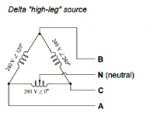Working on installing some electronics supplied by a three-phase four-wire high-leg (center-tapped) delta secondary and am wondering whether a switching PSU at 240V, 2 hots and a ground (C13 plug) could run into problems when the line to ground voltages vary between the two hots going into the PSU. There is a possibility to switch to an ungrounded 240V delta secondary (120V supplied from elsewhere) or a 208V wye configuration so feel free to comment on that if you wish.
Details:
Details:
- PSU is powered from a single phase panel that is completely wired with double-pole breakers in order to provide 240V L-L voltage (AC 60Hz).
- One of the panel's hot line is the high-leg of the delta secondary, which means that the line-ground voltages from the hot legs into the PSU are 208V and 120V.
- I don't have the schematics/diagram for the PSU but it's a generic 1800w server PSU; 1800w 200-240V AC to 12V DC (two V+ & 2 V- terminals). Internally the ground from the C14 plug is directly terminated to one the the PCB's mounting screws.
- Powered the unit up to roughly 50% load without a problem, yet (to either PSU or equipment).



